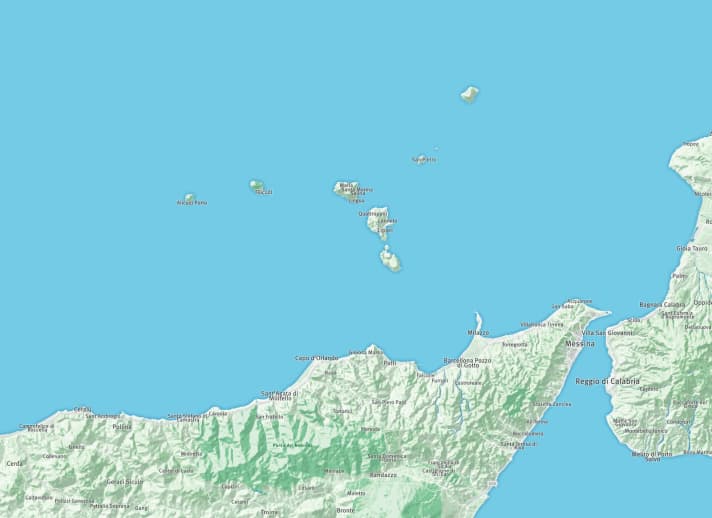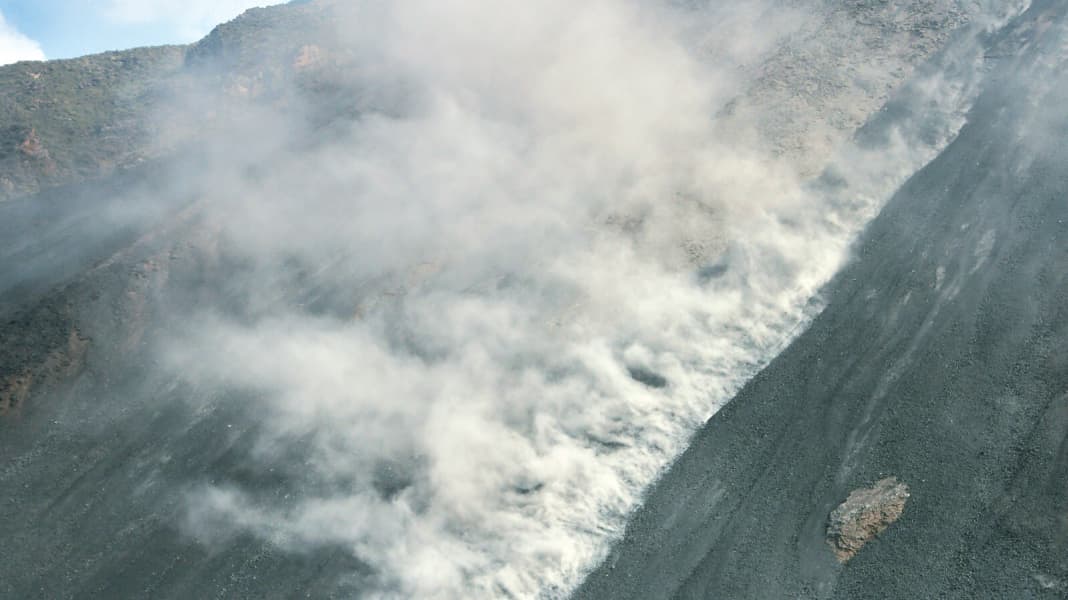
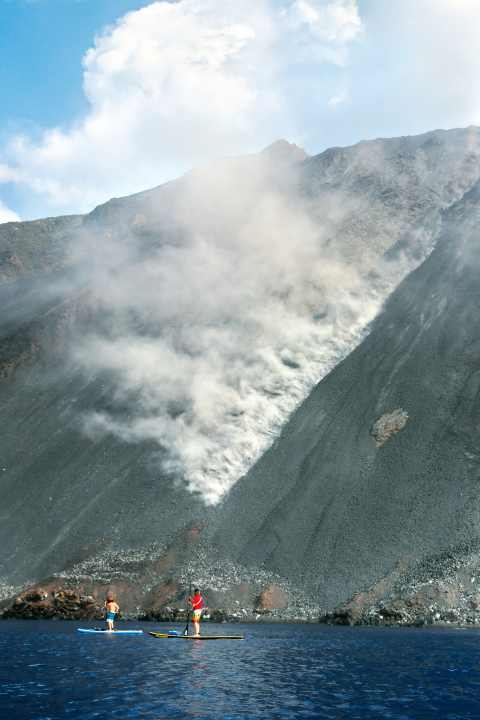
Lost in thought, he gazes down into the depths some 500 metres above the sea and breathes deeply, as if he could inhale the magnificent view. It smells of fig leaves, salt water and donkey droppings. In the cloudless sky, rare Eleonora's falcons hunt for songbirds and reptiles. He is not interested in the wild hustle and bustle in the still air. Instead, he sits relaxed on an old stone wall that he has restored for a friend. About 20 kilometres to the east, the islet of Filicudi rises 774 metres out of the water. Sometimes he thinks he could swim over there without any problems. He has an iron, well-trained body and more than twelve litres of lung capacity. He is a rescue diver and swimmer, comes from Dresden and is called David Albert. But then he drops the thought like a small child drops a toy and wanders off into the distance, where more volcanic islands are hidden in a haze. Today, he can clearly see the snow-white peak of Mount Etna on the horizon - there is something about active volcanoes that attracts people. The coast of Sicily is 60 kilometres away from his island, but life here seems to have been more than
100 years ago. He opens a beer with relish, which he has cooled in a cistern in the house - there is no fridge. There is no running water or electricity in the house where he lives - but it is quieter than many would like. The path to the only small village shop is 400 metres below him. There are no cars. Just an astonishing network of steps made of lava stones and mules that can carry loads to dizzying heights. He has been living here for four years - without interruption, to clear his head and soul and to find himself. Today, David is more reflective than usual. He feels he has arrived, and yet his heart vibrates like an active volcano. His island is an extinct volcano, spherical in shape, about four square kilometres in size and one of the loneliest spots in the entire Mediterranean. Even at the height of summer, only the occasional hiker strays onto the westernmost of the Aeolian Islands: Alicudi. There are neither hotels nor a proper beach. The small fishing village has just 130 inhabitants. But soon one less.
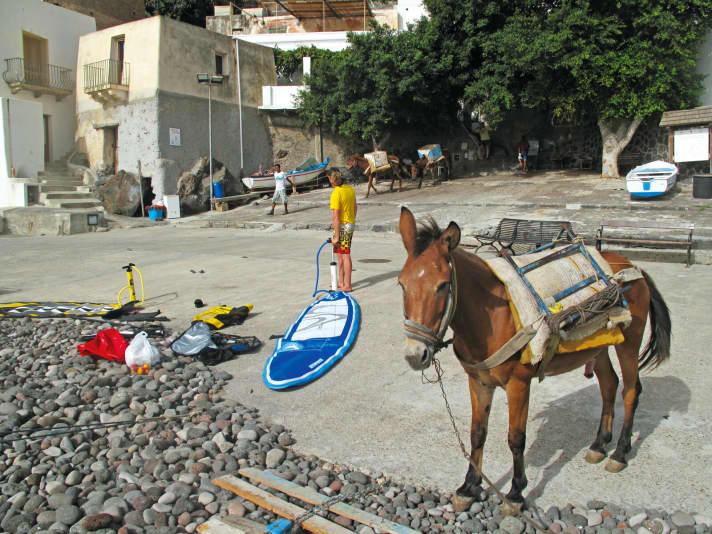
I meet David two years later on our Rail & SUP tour - in his new home of Stromboli. There is no city life here either, but there is a mighty volcano. And it is precisely this volcano that attracts not only David, but also us - and day tourists from all over the world. Stromboli is the only permanently active volcano in Europe. Even the ancient Greek and Roman sailors took their bearings from the almost 1,000 metre high, glowing cone, which is also known as the lighthouse of antiquity. We were impressed to see why when we arrived by boat from Naples: My friend Rafael Bach from Brazil, with whom I wanted to explore Stromboli from a stand-up board, shook my shoulder excitedly. It was pitch black. I was lying outside on the deck of a ferry. "Look, you have to see this!" And there it was, the rarest and yet most pristine sight in the history of the earth, which attracted David as much as it did us:
A glowing point in the middle of nowhere with an orange bubbling lava road to nowhere: Stromboli, the highest lighthouse in the world.
It was five o'clock in the morning and the ferry's cafeteria was just opening. Together with a rather short Rasta man, we ordered a coffee after the initial excitement. Bob Marley held out his hand to me and introduced himself as Christian from Holland. I met him with the same candour: "This is my friend Raffa from Brazil, he only looks so German because he lives in Italy. And I'm an American from Germany. But you don't exactly look like a Dutchman either." We laughed. And he told us about his origins: He was Ecuadorian by birth, grew up in Chile, and lives in Amsterdam. He was also a real volcano chaser and was here on assignment for National Geographic. We nodded in awe, almost in disbelief, with our steaming coffee cups in our hands and told him how much we were looking forward to this volcano.
I had originally planned this trip for March. Our photographer Jean Souville from France knew Stromboli from seeing it from a plane and had been dreaming of travelling there for a long time. Unfortunately, the small island can only be reached by ferry in good weather. In spring and winter, however, the storms rage here in the south - the Aeolian Islands are named after the Greek god of the wind for a reason. We had to reschedule for September. There was more time now and the sea was warmer - perfect for our planned excursions with the SUP boards. Raffa and I travelled by train and our iSUPs from Munich and Rovereto in Trentino to Naples. Jean was already in Sicily - and the fact that he only had a fixed board with him there unexpectedly brought us together with David and, almost six months later, Angelika Sair.
Angelika Sair is a lively and beautiful adventurer from Tyrol. She is just over 50 and has been running a small Centro Mare on Stromboli for 30 years - formerly a surfing and sailing school, now a kayak hire centre. Even though she loves the Caribbean and has crossed the Atlantic three times by sailing boat, Stromboli remains the pearl of the sea for her. "There are more and more volcano tourists who only stay for a few days, but the originality has remained," she explained to me at a meeting in Innsbruck in winter. Like the locals, she is not afraid of the constant eruptions. "A few years ago, a large bale of fire was thrown onto the northern flank above the village and set the slope on fire. Fortunately, the wind blew onshore and drove the flames back to their source," she reports. The extinct volcano on the neighbouring island is much more dangerous. This is also confirmed by the local Francesca, who runs a nice self-catering guesthouse there: "The volcano on Vulcano is a ticking time bomb because it's not active!" Like many locals, she can talk enthusiastically about the spitting mountain. Her father is an artist and creates whimsical sculptures from lava stones. Everyone benefits from Europe's most active volcano. Even the Austrian Barbara Engele with her B & B. One day, her friend Angelika asks her if she needs help on the beach. A young man from Dresden, who had helped her repair the house, spoke fluent Italian, was very sporty and was looking for work. The Tyrolean agrees and David starts first as a beach boy, then as a paddle tour guide on Stromboli.
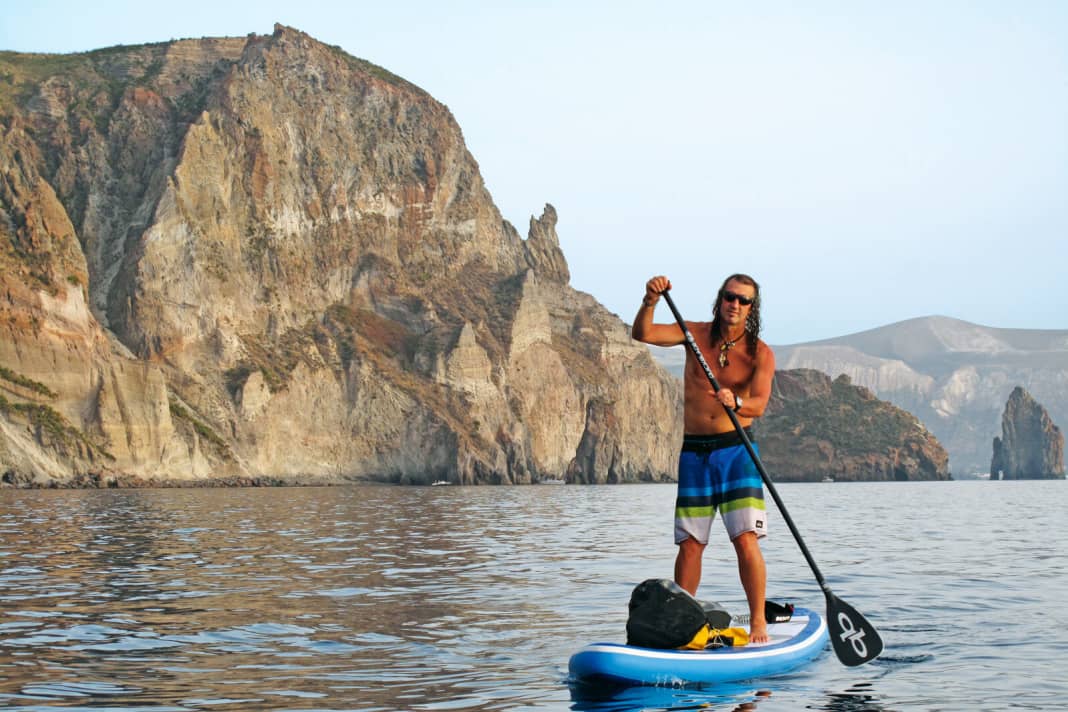





When our photographer Jean wants to join us by speedboat from Milazzo in Sicily, he is refused permission to take the fixed SUP board with him on the boat. But without a third board, we are at a loss: We have planned a trip around the island and want to paddle past the mighty Sciara del Fuoco (fire slide) - the glowing vein that we had already admired from the ferry during the night. So we make a pilgrimage to the small kayak hire shop and meet a tanned, muscular man with half-length, curly hair. His clear, green-blue eyes speak louder than he does. It's David. He is enthusiastic about our inflatable surfboards. Many people have already asked him about the SUP boards. Before we set off, he warns us about the rolling lava rocks of the Sciara del Fuoco. We should keep our distance as the volcano is very active at the moment. After a violent eruption in July, the summit is closed to everyone. David has been up there many times. He raves about the energy of the volcano. One day before the last eruption, he paddled around the island and climbed to the summit from the small fishing harbour of Ginostra. Tourists are not allowed to do this, but the local mountain guides turn a blind eye to David. "When I stood on the crater rim at dusk, I was overwhelmed by the bubbling. I've never seen so much life up there. The volcano spewed fountains into the air every few minutes. The sight was magnetising, especially at night," says the giant, glowing with enthusiasm. Suddenly, he recalls, there was a brief rumble under his feet and a tremendous explosion shook the summit.
A wall of magma shot about 350 metres into the air in front of him. The shock wave threw the German onto his back.
"That was a bit too much volcano for me," admits David humbly. He decided to retreat a few hundred metres, laid his sleeping mat on the ground and admired the spectacle from here all night. Since then, the summit area has also been closed to hikers with a guide, and a huge lava flow runs down the Sciara del Fuoco on the western flank of the mountain right into the water.
We paddle off. After just 15 minutes, we are overwhelmed by the sight of the young volcanic landscape: black, fine sandy beaches, gnarled rock formations in all shapes and sizes - as if the lava movement had abruptly frozen. A dead goat lies on the lava beach. We wonder how it got there and learn the next day from a local that goats love the fresh tufts of grass on the lava slope and are therefore left alone by the dogs in the village - a high price to pay for the quiet gourmet food. We glide silently on through the mirror-smooth water. Below us, the mountain drops some 2,000 metres into the depths. Suddenly it hisses and hisses, and the steaming giant towers in front of us with its huge lava and sand slide - the Sciara del Fuoco. Every second, small and large chunks of lava rumble down the dusty, hot slope, leaving trails of smoke in their wake. Here and there, a rock shatters and flares up red until it hisses and tumbles into the sea. As if magnetised, we let the hissing and bubbling draw us into the forbidden 200-metre zone. Impressive land is being reclaimed here, in the centre of Europe. At the top, at over 900 metres, you can hear thunder, like a thunderstorm. Then an entire rock face breaks off. Glowing lava colossi rush towards us, we turn our boards and paddle frantically out of the danger zone. Furious, we hiss and gurgle as the molten earth hits the cool water behind us. Then there is a brief silence - and everything starts all over again. We could watch this natural spectacle for hours, but if we want to complete the circumnavigation, time is of the essence. Only a light wind is blowing. We hope it stays that way. On the way to the small fishing harbour of Ginostra on the other side of the island, we witness a successful hunt by two peregrine falcons for a hoopoe. Again and again, they swoop down over our heads on the exhausted bird, which they have probably pushed from the other side into the unprotected lunar landscape. The victim saves itself next to us on a beach behind a lava rock. The falcons tirelessly attack their lunch. Feathers fly. I feel sorry for the rare, woodpecker-like creature and steer very close. Only now do the raptors notice us and take flight - perhaps long enough for the hoopoe to recover. For us, however, there is hardly any time to recover. A cool Coke in the only restaurant in Ginostra with a wonderful view of the neighbouring islands of Panarea, Lipari, Salina and Vulcano, then we paddle back to the village of Stromboli for an hour.
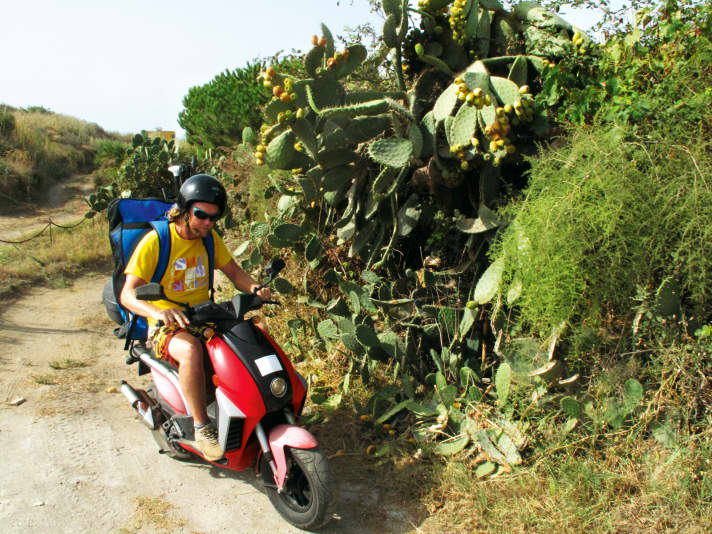
The uncertainty of not being able to leave the island due to unfavourable weather and sea conditions gives Stromboli a charm that does not appeal to all tourists. The reason for this is the exposed island coastline without a protective harbour. But even hot-headed Sicilians can sometimes be to blame for the failure of the means of transport - as on the evening of Jean's departure: the helmsman and captain endeavour to dock in rough seas. But without success. The captain of the crew on the jetty at Stromboli begins to shout at the captain, gesticulating wildly. The captain calmly invites the rebellious shouter into the cockpit. He refuses, believing himself to be in the right. The already somewhat insecure passengers then witness a drama fit for a film: wild insults fly back and forth - and although the speedboat is able to dock after all, the captain forbids his crew to tie up the jetty. A scuffle breaks out between the crew on board and the shore crew. The police are called. The only policeman on the island, a young rookie with gelled hair, appears with his electric ape and is allowed onto the boat. To add fuel to the fire, the capo's wife appears, argues loudly with her husband and threatens to divorce him. Our photographer, a rascal from Marseille, senses what is coming and pushes his way in front of the more than 30 waiting passengers. When the policeman is let back ashore via the jetty, he quickly jumps onto the only connection to the boat with his travelling bag - and is pulled into the boat by the crew. The engines rev up - and the ferry departs with just one passenger: our photographer! The next ferry arrives in about twelve hours. The islanders call it force majeure - "that's the way it is" - and shrug their shoulders. The tourists just look stupid. Me too.
We don't know what to expect next week on the other islands. We want to paddle around Lipari and Vulcano and, above all, explore David's favourite island: Alicudi. I'm impressed by his stories and want to paddle round his little island with Raffa. David has also circumnavigated it - by swimming. He speaks fondly of his time as a hermit, even though his marriage there fell apart. His calm demeanour has adapted to the heartbeat of the islands. I doubt whether he has the same temperamental outbursts of emotion as the locals from time to time. But just like the people of Stromboli themselves, he finds it difficult to stay on the island. But even harder to leave. So he stays.
...
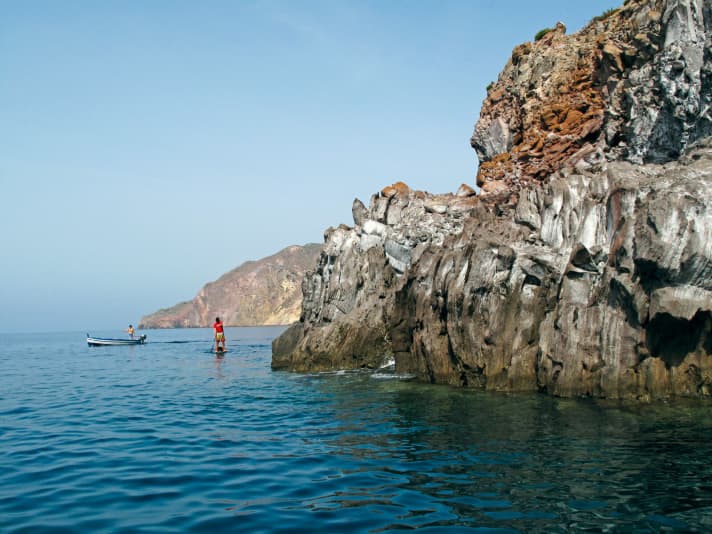
INFO LIPARI ISLANDS
About 40 kilometres north of Sicily lie the Aeolian Islands. These are seven charming pearls: Stromboli, Panarea, Lipari, Vulcano, Salina, Filicudi and Alicudi. The beautiful archipelago in the southern Mediterranean is of volcanic origin. Stromboli is the most active volcano in Europe next to Mount Etna. Even on Vulcano it is still bubbling and seething. The crystal-clear water makes the islands the perfect SUP paradise.
Arrival By train from Munich via Bolzano, Florence, Rome to Naples (or by overnight train to Milazzo on Sicily. From the station, take the bus to the harbour for two euros). The Italian express trains (Frecciarossa, Frecciargento) are comparable to the ICE - and a lot cheaper. There are regular ferries and speedboats from Naples to Stromboli and Lipari (journey time around eight hours). In the low season, the car ferry (cars are not allowed on the islands) departs about twice a week, wind and weather conditions permitting. The connections from Milazzo are easier and shorter. Info: www.siremar.it or www.usticalines.it
Travelling time The best time to visit is May to June and September to November. However, if you are on holiday on Stromboli, you should be aware that you may not always be able to arrive and depart on time in stormy weather.
Where to sleep?
Stromboli: An absolute tip for self-catering travellers: - Casa del Sole, tasteful shared rooms, communal kitchen. Tel. +39/347/0045376, info www.casadelsolestromboli.it
Wonderfully secluded and rustic in a remote fishing villageGinostra: - L'incontro: www.ginostraincontro.it
Lipari Wildly romantic and secluded in the mountains: - Agritourismo La Dolce Vita, www.ladolcevitalipari.it
The onlyCampsite onLipari - Camping Baia Unci in Canneto, www.campingbaiaunci.it
Vulcano - Camping Eden Park, edenpark@edenpark.info
Where to eat?
Stromboli If you hike up the volcano or to the viewpoint, you should stop off at the L'Osservatorio pizzeria on the way back.
Lipari There are many nice fish restaurants and pizzerias in Lipari town. We enjoyed the Trattoria da Bartolo and the Pizzeria Bellini, as well as the beach bar at Canneto: Blu Lounge. For fish: - Ristorante Filippino. Somewhat hidden in the old town of Lipari but super tasty. Ice cream: - Gelateria Giovani d'Ambra, via Morfeo 50.Vulcano - Ristorante Don Piricuddu below the volcano.
Scooter hire Lipari www.pitstopnoleggio.it
SUP and kayak hire - Stromboli Centro Mare Stromboli, Angelika Sair - and David Albert, 0043/6507640345 - or enter Centro Mare Stromboli on Facebook.
Literature The Bible of the Aeolian Islands: Thomas Schröder, Lipari Islands, Michael Müller Verlag.
Three scenically stunning tours (always ride with a leash)
- Stromboli - Tour 1: Stromboli to Ginostra past the Sciara del Fuoco (approx. 6-7 kilometres one way). Either when there is no wind or a light easterly wind. If necessary, boats also return from Ginostra during the season. A guide such as David Albert (see above for contact details) is recommended.
- Lipari - Tour 2: From Canneto to Porticello past the magnificent pumice stone factory ruins and white beaches (approx. 2.5 kilometres one way). Also possible in westerly winds as it is covered.
- Tour 3 - From Spiagga Valle Muria to the southern tip of Lipari (approx. 2.0 kilometres one way). Head towards Belvedere Quattrocchi, then left towards San Bartalo al Monte. In the hollow, a footpath on the right leads down to the beach for about 600 metres. Only rideable when there is no wind or a light easterly wind.
